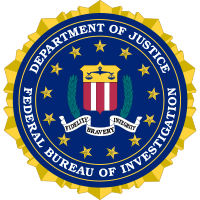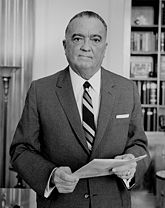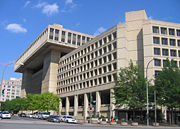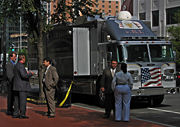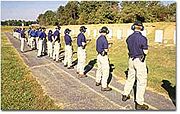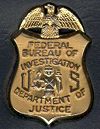Federal Bureau of Investigation
2008/9 Schools Wikipedia Selection. Related subjects: Law
| Federal Bureau of Investigation | |||||||||
| Abbreviation | FBI | ||||||||
| Seal of the Federal Bureau of Investigation | |||||||||
| Motto | Fidelity, Bravery, Integrity | ||||||||
| Agency Overview | |||||||||
|---|---|---|---|---|---|---|---|---|---|
| Formed | 1908 | ||||||||
| Employees | 30,847 ( June 30, 2008) | ||||||||
| Annual Budget | 6.4 billion USD ( 2007) | ||||||||
| Legal personality | Governmental agency | ||||||||
| Jurisdictional Structure | |||||||||
| Federal agency (Operations jurisdiction) |
United States | ||||||||
| Legal jurisdiction | As per operations jurisdiction. | ||||||||
| Governing body | United States Congress | ||||||||
| Constituting instrument | United States Code Title 28 Part II Chapter 33 | ||||||||
| General nature |
|
||||||||
| Operational Structure | |||||||||
| Headquarters | J. Edgar Hoover Building, Washington, D.C. | ||||||||
| Sworn members | 12,737 ( June 30, 2008) | ||||||||
| Unsworn members | 18,110 ( June 30, 2008) | ||||||||
| Agency executives |
|
||||||||
| Child agencies |
|
||||||||
| Major units |
5
|
||||||||
| Field offices | 56: List of FBI Field Offices | ||||||||
|
|||||||||
| Website | |||||||||
| http://www.fbi.gov/ | |||||||||
| this information |
|||||||||
The Federal Bureau of Investigation (FBI) is the primary investigative arm of the United States Department of Justice (DOJ), serving as both a federal criminal investigative body and a domestic intelligence agency. At present, the FBI has investigative jurisdiction over violations of more than 200 categories of federal crimes, making the FBI the de-facto lead law enforcement agency of the United States government. The motto of the bureau is "Fidelity, Bravery, Integrity".
The FBI headquarters is in Washington, D.C., and there are also 56 field offices located in major cities throughout the United States as well as over 400 resident agencies in smaller cities and towns across the nation, and more than 50 international offices, called "Legal Attachés", in U.S. embassies worldwide.
Mission and priorities
In fiscal year 2006, the FBI's total budget was approximately $8.7 billion, including $495 million in program increases to enhance counter-terrorism, counterintelligence, cyber crime, information technology, security, forensics, training, and criminal programs. According to its congressional budget justification for the fiscal year 2009, for the past several years the FBI has assumed a growing responsibility for collecting foreign intelligence, in response to a May, 2006 request from the Director of National Intelligence.
It was established in 1908 as the Bureau of Investigation (BOI), and the name was changed to the FBI in 1935.
The mission of the FBI is "To protect and defend the United States against terrorist and foreign intelligence threats, to uphold and enforce the criminal laws of the United States, and to provide leadership and criminal justice services to federal, state, municipal, and international agencies and partners."
Currently, the FBI's top investigative priorities are:
- Protect the United States from terrorist attack (see counter-terrorism);
- Protect the United States against foreign intelligence operations and espionage (see counter-intelligence);
- Protect the United States against cyber-based attacks and high-technology crimes (see cyber-warfare);
- Combat public corruption at all levels;
- Protect civil rights;
- Combat transnational/national criminal organizations and enterprises (see organized crime);
- Combat major white-collar crime;
- Combat significant violent crime;
- Support federal, state, local and international partners; and
- Upgrade technology for successful performance of the FBI's mission.
In August 2007, the top categories of lead criminal charges resulting from FBI investigations were:
- Bank robbery and incidental crimes (107 charges)
- Drugs (104 charges)
- Attempt and conspiracy (81 charges)
- Material involving sexual exploitation of minors (53 charges)
- Mail fraud - frauds and swindles (51 charges)
- Bank fraud (31 charges)
- Prohibition of illegal gambling businesses (22 charges)
- Fraud by wire, radio, or television (20 charges)
- Hobbs Act (17 charges)
- RICO - prohibited activities (17 charges)
Legal authority
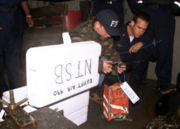
The FBI's mandate is established in Title 28 of the United States Code (U.S. Code), Section 533, which authorizes the Attorney General to "appoint officials to detect... crimes against the United States." Other federal statutes give the FBI the authority and responsibility to investigate specific crimes.
The USA PATRIOT Act increased the powers allotted to the FBI, especially in wiretapping and monitoring of Internet activity. One of the most controversial provisions of the act is the so-called sneak and peek provision, granting the FBI powers to search a house while the residents are away, and not requiring them to notify the residents for several weeks afterwards. Under the PATRIOT Act's provisions the FBI also resumed inquiring into the library records of those who are suspected of terrorism (something it had supposedly not done since the 1970s).
The FBI's chief tool against organized crime is the Racketeer Influenced and Corrupt Organizations (RICO) Act. The FBI is also charged with the responsibility of enforcing compliance of the United States Civil Rights Act of 1964 and investigating violations of the act in addition to prosecuting such violations with the United States Department of Justice (DOJ). The FBI also shares concurrent jurisdiction with the Drug Enforcement Administration (DEA) in the enforcement of the Controlled Substances Act of 1970.
Information obtained through an FBI investigation is presented to the appropriate US Attorney or Department of Justice (DOJ) official, who decides if prosecution or other action is warranted.
History
In 1886, the Supreme Court, in Wabash, St. Louis & Pacific Railroad Company v. Illinois, found that the states had no power to regulate interstate commerce. The resulting Interstate Commerce Act of 1887 created a Federal responsibility for interstate law enforcement. The Justice Department, which had hired few permanent investigators since its establishment in 1870, made little effort to relieve its staff shortage until the turn of the century, when Attorney General Charles Joseph Bonaparte reached out to other agencies, including the Secret Service, for investigators. But Congress forbade this use of Treasury employees by Justice, passing a law to that effect in 1908. So the Attorney General moved to organize a formal Bureau of Investigation (BOI), complete with its own staff of special agents. Its jurisdiction derived from the Interstate Commerce Act of 1887. The FBI grew out of this force of Special Agents created on July 26, 1908 during the presidency of Theodore Roosevelt. Its first official task was visiting and making surveys of the houses of prostitution (in preparation for enforcing 'The White Slave Traffic Act' passed on June 25, 1910). In 1932, it was renamed the United States Bureau of Investigation. The following year it was linked to the Bureau of Prohibition and rechristened the Division of Investigation (DOI) before finally becoming the FBI in 1935.
The director of the old BOI, J. Edgar Hoover, became the first FBI director and served for nearly 48 years. After Hoover's death, legislation was passed limiting the tenure of future FBI directors to a maximum of ten years. The Scientific Crime Detection Laboratory, or the FBI Laboratory, officially opened in 1932, largely as a result of Hoover's efforts. Hoover had substantial involvement in most cases and projects the FBI handled during his tenure.
During the so-called "war on crime" of the 1930s, FBI agents apprehended or killed a number of notorious criminals who carried out a number of kidnappings, robberies, and murders throughout the nation, including John Dillinger, "Baby Face" Nelson, Kate "Ma" Barker, Alvin "Creepy" Karpis, and George "Machine Gun" Kelly. While this campaign, as well as the campaign to build-up the FBI, was carried out in response to a national crime wave, most historians now believe that if there was a crime wave at all, it was grossly exaggerated during the Great Depression.
Other activities of its early decades included a decisive role in reducing the scope and influence of the Ku Klux Klan. Additionally, through the work of Edwin Atherton, the FBI claimed success in apprehending an entire army of Mexican neo-revolutionaries along the California border in the 1920s.
Beginning in the 1940s and continuing into the 1970s, the Bureau investigated cases of espionage against the United States and its allies. Eight Nazi agents who had planned sabotage operations against American targets were arrested, six of whom were executed ( Ex parte Quirin). Also during this time, a joint US/UK code breaking effort ( Venona)—with which the FBI was heavily involved—broke Soviet diplomatic and intelligence communications codes, allowing the US and British governments to read Soviet communications. This effort confirmed the existence of Americans working in the United States for Soviet intelligence. Hoover was administering this project but failed to notify the Central Intelligence Agency (CIA) until 1952. Another notable case is the arrest of Soviet spy Rudolf Abel in 1957. The discovery of Soviet spies operating in the US allowed Hoover to pursue his longstanding obsession with the threat he perceived from the American left, ranging from Communist Party of the United States of America (CPUSA) union organizers to American liberals with no revolutionary aspirations whatsoever.
During the 1950s and 1960s, FBI officials became increasingly concerned about the influence of civil rights leaders. In 1956, for example, Hoover took the rare step of sending an open letter denouncing Dr. T.R.M. Howard, a civil rights leader, surgeon, and wealthy entrepreneur in Mississippi who had criticized FBI inaction in solving recent murders of George W. Lee, Emmett Till, and other blacks in the South. The FBI carried out controversial domestic surveillance in an operation called COINTELPRO. It aimed at investigating and disrupting dissident political organizations within the United States, including both militant and non-violent organizations, including the Southern Christian Leadership Conference, a leading civil rights organization.
Martin Luther King, Jr. was a frequent target of investigation. The FBI found no evidence of any crime, but attempted to use tapes of King involved in sexual activity for blackmail. In his 1991 memoirs, Washington Post journalist Carl Rowan asserted that the FBI had sent at least one anonymous letter to King encouraging him to commit suicide.
When President John F. Kennedy was shot and killed, the jurisdiction fell to the local police departments until President Lyndon B. Johnson directed the FBI to take over the investigation. To ensure that there would never be any more confusion over who would handle homicides at the federal level, Congress passed a law that put investigations of deaths of federal officials within FBI jurisdiction.
After the Racketeer Influenced and Corrupt Organizations Act (RICO Act) took effect, the FBI began investigating the former Prohibition organized groups, which by now become fronts for crime in major cities and even small towns. All of the FBI work was done undercover and from within these organizations using the provisions provided in the RICO Act and these groups were dismantled. Although Hoover initially denied the existence of a close-knit organized crime network in the United States, the Bureau later conducted operations against known organized crime syndicates and families, including those headed by Sam Giancana and John Gotti. The RICO Act is still used today for all organized crime and any individuals that might fall under the Act.
In 1984, the FBI formed an elite SWAT team to help with problems that might arise at the 1984 Summer Olympics, particularly terrorism and major-crime. The formation of the team arose from the 1972 Summer Olympics at Munich, Germany when terrorists murdered Israeli Athletes. The team was named Hostage Rescue Team (HRT) and acts as the FBI lead for SWAT related procedures and all counter terrorism cases. Also formed in 1984 was the Computer Analysis and Response Team (CART). The end of the 1980s and the early part of the 1990s saw the reassignment of over 300 agents from foreign counter intelligence duties to violent crime and the designation of violent crime as the sixth national priority. But with reduced cuts to other well-established departments, and because terrorism was not longer considered a threat after the end of the Cold War, the FBI became a tool of local police forces for tracking fugitives who had crossed state lines, which was a felony. The FBI Laboratory also helped develop DNA testing, continuing the pioneering role in identification that began with its fingerprinting system in 1924.
Between 1993 and 1996, the FBI increased its counter-terrorism role in the wake of the first 1993 World Trade Centre bombing in New York, New York and the Oklahoma City bombing in 1995, and the arrest of the Unabomber in 1996. Technological innovation and the skills of FBI Laboratory analysts helped ensure that all three of these cases were successfully prosecuted, but the FBI was also confronted by a public outcry in this period, which still haunts it today. After Congress passed the Communications Assistance for Law Enforcement Act (CALEA, 1994), the Health Insurance Portability and Accountability Act (HIPA, 1996), and the Economic Espionage Act (EEA, 1996), the FBI followed suit and underwent a technological upgrade in 1998, just as it did with its CART team in 1991. Computer Investigations and Infrastructure Threat Assessment Centre (CITAC) and the National Infrastructure Protection Centre (NIPC) were created to deal with the increase in Internet-related problems, such as computer viruses, worms, and other malicious programs that might unleash havoc in the US. With these developments, the FBI increased its electronic surveillance in public safety and national security investigations, adapting to how telecommunications advancements changed the nature of such problems.
Within months of the September 11, 2001 attacks, FBI Director Robert Mueller, who was only sworn in three days before the attacks, called for a re-engineering of FBI structure and operations. In turn, he made countering every federal crime a top priority, including the prevention of terrorism, countering foreign intelligence operations, addressing cyber security threats, other high-tech crimes, protecting civil rights, combating public corruption, organized crime, white-collar crime, and major acts of violent crime.
Organization
The FBI is headquartered at the J. Edgar Hoover Building in Washington, D.C., with 56 field offices in major cities across the United States. The FBI also maintains over 400 resident agencies across the United States, as well as over 50 legal attachés at United States embassies and consulates. Many specialized FBI functions are located at facilities in Quantico, Virginia, as well as in Clarksburg, West Virginia. The FBI is in process of moving its Records Management Division, which processes FOIA requests, to Winchester, Virginia.
The FBI Laboratory, established with the formation of the BOI, did not appear in the J. Edgar Hoover Building until its completion in 1974. The lab serves as the primary lab for most DNA, biological, and physical work. Public tours of FBI headquarters ran through the FBI laboratory workspace before the move to the J. Edgar Hoover Building. The services the lab conducts include Chemistry, Combined DNA Index System (CODIS), Computer Analysis and Response, DNA Analysis, Evidence Response, Explosives, Firearms and Tool marks, Forensic Audio, Forensic Video, Image Analysis, Forensic Science Research, Forensic Science Training, Hazardous Materials Response, Investigative and Prospective Graphics, Latent Prints, Materials Analysis, Questioned Documents, Racketeering Records, Special Photographic Analysis, Structural Design, and Trace Evidence. The services of the FBI Laboratory are used by many state, local, and international agencies free of charge. The lab also maintains a second lab at the FBI Academy.
The FBI Academy, located in Quantico, Virginia, is home to the communications and computer laboratory the FBI utilizes. It is also where new agents are sent for training to become FBI Special Agents. Going through the twenty-one week course is required for every Special Agent. It was first opened for use in 1972 on 385 acres (1.6 km²) of woodland. The Academy also serves as a classroom for state and local law enforcement agencies who are invited onto the premiere law enforcement training centre. The FBI units that reside at Quantico are the Field and Police Training Unit, Firearms Training Unit, Forensic Science Research and Training Centre, Technology Services Unit (TSU), Investigative Training Unit, Law Enforcement Communication Unit, Leadership and Management Science Units (LSMU), Physical Training Unit, New Agents' Training Unit (NATU), Practical Applications Unit (PAU), the Investigative Computer Training Unit and the "College of Analytical Studies."
The Criminal Justice Information Services (CJIS) Division, located in Clarksburg, West Virginia. It is the youngest division of the FBI only being formed in 1991 and opening in 1995. The complex itself is the length of three football fields. Its purpose is to provide a main repository for information. Under the roof of the CJIS are the programs for the National Crime Information Centre (NCIC), Uniform Crime Reporting (UCR), Fingerprint Identification, Integrated Automated Fingerprint Identification System (IAFIS), NCIC 2000, and the National Incident-Based Reporting System (NIBRS). Many state and local agencies use these systems as a source for their own investigations and contribute to the database using secure communications. FBI provides these tools of sophisticated identification and information services to local, state, federal, and international law enforcement agencies.
The FBI often works in conjunction with other Federal agencies, including the United States Coast Guard and Customs and Border Protection (CBP) in seaport security, and the National Transportation Safety Board in investigating airplane crashes and other critical incidents. Immigration and Customs Enforcement (ICE) is the only other agency with the closest amount of investigative power. In the wake of the September 11, 2001 attacks, the FBI maintains a role in most federal criminal investigations.
The FBI is organized in the following manner.
- National Security Branch
- Counterintelligence Division
- Counterterrorism Division
- Directorate of Intelligence
- Criminal Investigations Branch
- Criminal Investigative Division
- Cyber Division
- Law Enforcement Services Branch
- Criminal Justice Information Services Division
- Critical Incident Response Group
- Laboratory Division
- Office of International Operations
- Office of Law Enforcement Coordination
- Operational Technology Division
- Training & Development Division
- Administration Branch
- Administrative Services Division
- Facilities & Logistics Services Division
- Finance Division
- Records Management Division
- Security Division
- Office of the Chief Information officer
- Information Technology Operations Division
- Office of IT Policy & Planning
- Office of IT Program Management
- Office of IT Systems Development
BOI and FBI directors
FBI Directors are appointed by the President of the United States. They must be confirmed by the United States Senate and serve ten-year terms. J. Edgar Hoover, appointed by Calvin Coolidge in 1924, was by far the longest-serving FBI Director, serving until his death in 1972. In 1968, Congress passed legislation as part of the Omnibus Crime Control and Safe Streets Act Pub.L. 90-351, June 19, 1968, 82 Stat. 197 that specified a 10-year term limit for future FBI Directors, as well as requiring Senate confirmation of appointees. As the incumbent, this legislation did not apply to Hoover, only to his successors. The current FBI Director is Robert Mueller, who was appointed in 2001 by George W. Bush.
The FBI director is responsible for the day-to-day operations at the FBI. Along with his deputies, the director makes sure cases and operations are handled correctly. The director also is in charge of making sure the leadership in any one of the FBI field offices are manned with qualified agents. Before the Intelligence Reform and Terrorism Prevention Act was passed in the wake of the September 11, 2001 attacks, the FBI director would brief the President of the United States on any issues that arise from within the FBI. Since then, the director now reports to the Director of National Intelligence (DNI) who in turn reports to the President.
Hiring process
While the exact process and details are classified, the process of becoming an employee of the FBI is arduous. At a minimum, FBI employees require a Top Secret (TS) security clearance, and in many instances, employees need a higher level, TS/SCI clearance. In order to get a security clearance, all potential FBI personnel must pass a series of Single Scope Background Investigations (SSBI), which are conducted by the Office of Personnel Management. Special Agents candidates also have to pass a rigorous Physical Fitness Test (PFT) that includes a 300-meter run, one-minute sit-ups, maximum push-ups, and a 1.5-mile (2.4 km) run. There is also a random drug test all FBI personnel have to pass in order to become an agent. In addition to the drug test, there is a polygraph test personnel have to pass, with questions including possible drug use. After potential special agent candidates are cleared with TS clearance and the Form SF-312 non-disclosure agreement is signed, they attend the FBI training facility located on Marine Corps Base Quantico in Virginia. Candidates spend approximately 21 weeks at the FBI Academy, where they receive over 500 classroom hours and over 1000 simulated law enforcement hours to train. Upon graduation, new FBI Special Agents are placed all around the country and the world, depending on their areas of expertise. Professional support staff works out of one of the many support buildings the FBI maintains. However, any Agent or Support staff member can be transferred to any location for any length of time if their skills are deemed necessary at one of the FBI field offices or one of the 400 resident agencies the FBI maintains.
As of October 31, 2006, the FBI had a total of 30,762 employees. That includes 12,659 special agents and 18,009 support staff, such as FBI police officers, intelligence analysts, language specialists, scientists, information technology specialists, and other professionals.
Publications
The FBI Law Enforcement Bulletin is published monthly by the FBI Law Enforcement Communication Unit, with articles of interest to state and local law enforcement personnel. First published in 1932 as Fugitives Wanted by Police, the FBI Law Enforcement Bulletin covers topics including law enforcement technology and issues, such as crime mapping and use of force, as well as recent criminal justice research, and Vi-CAP alerts, on wanted suspects and key cases.
The FBI also publishes some reports for both law enforcement personnel as well as regular citizens covering topics including law enforcement, terrorism, cybercrime, white-collar crime, violent crime, and statistics. However, the vast majority of Federal government publications covering these topics are published by the Office of Justice Programs agencies of the United States Department of Justice, and disseminated through the National Criminal Justice Reference Service.
Crime statistics
Uniform Crime Reports
The Uniform Crime Reports (UCR) compile data from over 17,000 law enforcement agencies across the country. They provide detailed data regarding the volume of crimes to include arrest, clearance (or closing a case), and law enforcement officer information. The UCR focuses its data collection on violent crimes, hate crimes, and property crimes. Created in the 1920s, the UCR system has not proven to be as uniform as its name implies. The UCR data only reflect the most serious offense in the case of connected crimes and has a very restrictive definition of rape. Since about 93% of the data submitted to the FBI is in this format, the UCR stands out as the publication of choice as most states require law enforcement agencies to submit this data.
Preliminary Annual Uniform Crime Report for 2006 was released on June 4, 2006. The report shows violent crime offenses rose 1.3%, but the number of property crime offenses decreased 2.9% compared to 2005.
National Incident Based Reporting System
The National Incident Based Reporting System (NIBRS) crime statistics system aims to address limitations inherent in UCR data. The system used by law enforcement agencies in the United States for collecting and reporting data on crimes. Local, state, and federal agencies generate NIBRS data from their records management systems. Data is collected on every incident and arrest in the Group A offense category. The Group A offenses are 46 specific crimes grouped in 22 offense categories. Specific facts about these offenses are gathered and reported in the NIBRS system. In addition to the Group A offenses, eleven Group B offenses are reported with only the arrest information. The NIBRS system is in greater detail than the summary-based UCR system. As of 2004, 5,271 law enforcement agencies submitted NIBRS data. That amount represents 20% of the United States population and 16% of the crime statistics data collected by the FBI.
Criticism
The FBI has endured public criticism and internal conflict in the past decade. As the FBI attempts to modernize technologically to take on a greater counter-terrorism role, there have been times where the FBI is scrutinized.
Most of the recent controversies in the FBI have been involved with "terrorist" organizations or "operational" mishaps. In the early and late 1990s, its role in the Ruby Ridge and Waco incidents caused an uproar over the tactics that were used. During the 1996 Summer Olympics in Atlanta, Georgia, the FBI was also criticized for its investigation on the Centennial Olympic Park bombing. It has recently settled a dispute with Richard Jewell, who was a private security guard at the venue, along with some media organizations, in regards to the leaking of his name during the investigation. In the 1990s, it turned out that the fingerprint unit of the FBI's crime lab had repeatedly done shoddy work. In some cases, the technicians, given evidence that actually cleared a suspect, reported instead that it proved the suspect guilty. Many cases had to be reopened when this pattern of errors was discovered.
In 2000, the FBI began the Trilogy project to upgrade its outdated IT infrastructure. This project, originally scheduled to take three years and cost around $380 million, ended up going far over budget and behind schedule. Efforts to deploy modern computers and networking equipment were generally successful, but attempts to develop new investigation software, outsourced to SAIC, were a disaster. Virtual Case File, or VCF, as the software was known, was plagued by poorly defined goals, and repeated changes in management. In January 2005, more than two years after the software was originally planned for completion, the FBI officially abandoned the project. At least $100 million (and much more by some estimates) was spent on the project, which was never operational. The FBI has been forced to continue using its decade-old Automated Case Support system, which is considered woefully inadequate by IT experts. In March 2005, the FBI announced it is beginning a new, more ambitious software project code-named Sentinel expected for completion by 2009.
In February 2001, Robert Hanssen was caught selling information to the Russians. It was later learned that Hanssen, who had reached a high position within the FBI, had been selling intelligence since as early as 1979. He pleaded guilty to treason and received a life sentence in 2002, but the incident led many to question the security practices employed by the FBI. There was also a claim that Robert Hanssen might have contributed information that led to the September 11, 2001 attacks.
The 9/11 Commission's final report on July 22, 2004 stated that the FBI and CIA were both partially to blame for not pursuing intelligence reports which could have prevented the September 11, 2001 attacks. In its most condemning assessment, the report concluded that the country had "not been well served" by either agency and listed numerous recommendations for changes within the FBI. While the FBI has acceded to most of the recommendations, including oversight by the new Director of National Intelligence, some former members of the 9/11 Commission publicly criticized the FBI in October 2005, claiming it was resisting any meaningful changes.
On July 8, 2007 the Washington Post published excerpts from UCLA Professor Amy Zegart's book Spying Blind: The CIA, the FBI, and the Origins of 9/11. The article reported that government documents show the CIA and FBI missed 23 potential chances to disrupt the terrorist attacks of September 11, 2001. The primary reasons for these failures included: agency cultures resistant to change and new ideas; inappropriate incentives for promotion; and a lack of cooperation between the FBI, CIA and the rest of the United States Intelligence Community. The article went on to also blame the FBI's decentralized structure which prevented effective communication and cooperation between different FBI offices. The article also claimed that the FBI has still not evolved into an effective counterterrorism or counterintelligence agency, due in large part to deeply ingrained cultural resistance to change within the FBI. For example, FBI personnel practices continue to treat all staff other than Special Agents as support staff, categorizing Intelligence Analysts alongside the FBI's auto mechanics and janitors.
A March 2007 report by the inspector general of the Justice Department described the FBI's "widespread and serious misuse" of national security letters, a form of administrative subpoena used to demand records and data pertaining to individuals. The report said that between 2003 and 2005 the FBI had issued more than 140,000 national security letters, many involving people with no obvious connections to terrorism.
Faulty Bullet Lead Analysis Testimony
For over 40 years, the FBI crime lab in Quantico believed lead in bullets had unique chemical signatures, and that by breaking them down and analyzing them, it was possible to match bullets, not only to a single batch of ammunition coming out of a factory, but to a single box of bullets. The National Academy of Sciences conducted an 18 month independent review of comparative bullet lead analysis. In 2003, its National Research Council published a report calling into question 30 years of FBI testimony. It found the model the FBI used for interpreting results was deeply flawed and that the conclusion that bullet fragments could be matched to a box of ammunition so overstated, that it was misleading under the rules of evidence. One year later, the FBI decided to stop doing bullet lead analysis.
Of over 2500 cases using this analysis, there are potentially hundreds or thousands where FBI lab technicians provided forensic testimony at criminal trials. In each case, the testimony was wrong and misleading. The U.S. Government has a legal obligation to notify defendants about any information that might help prove their innocence, even after they have been convicted. Only the FBI can identify the cases in which bullet lead analysis was performed, yet it has resisted releasing that information.
As a result of the 60 Minutes-Washington Post investigation in November, 2007, (two years later) the bureau said it will identify, review and release all of the pertinent cases, and notify prosecutors about cases in which faulty testimony was given.
FBI Knowingly Assisted In Wrongful Conviction of Murder
Protecting an informant, the FBI allowed four innocent men to be convicted of murder in March 1965. Three of the men were sentenced to death (which was later reduced to life in prison). The fourth defendant was sentenced to life in prison, where he spent three decades.
In July, 2007, U.S. District Judge Nancy Gertner in Boston found the bureau helped convict the four men of the March 1965 gangland murder of Edward "Teddy" Deegan. The U.S. Government was ordered to pay $100 million in damages to the four defendants.
FBI files on specific persons
It is possible to obtain a copy of an FBI file on yourself, on a living person who gives you permission to do so, or on a deceased individual through the U.S. Freedom of Information Act. The FBI has generated files on numerous celebrities including Elvis Presley, Frank Sinatra, John Denver, John Lennon, Jane Fonda, Groucho Marx, Charlie Chaplin, MC5, Lou Costello, Sonny Bono, Mickey Mantle, and Gene Autry.
